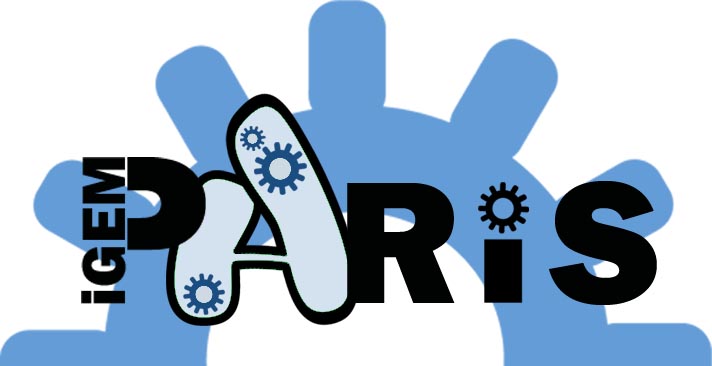Team:Paris
From 2008.igem.org
(→Where and when iGEM08 Paris took place ?) |
(→About our project) |
||
| Line 18: | Line 18: | ||
* Oscillatory system : It will consist in providing a periodic output for the duration of the experiment. To do so, we will use a genetic cascade, initiated by a specific inducer which last step will inhibit the previously mentioned inducer. | * Oscillatory system : It will consist in providing a periodic output for the duration of the experiment. To do so, we will use a genetic cascade, initiated by a specific inducer which last step will inhibit the previously mentioned inducer. | ||
| - | * FIFO System : The period of the oscillation is even more interesting | + | * FIFO System : The period of the oscillation is even more interesting if fit allows the sequential switching on and off of several genes. Our setup involves three genes which will get activated and desactivated successively as a “FIFO : First In, First Out”. This sequence is monitored by a logic structure called Feed-Forward Loop (FFL). |
| - | * Synchronization : Yet, being able to control this sequential activation within a single cell can be seen as a “first step” in biological clock devising. In order to amplify this phenomenon (to observe it in an easier way or even to find future applications), it has to be | + | * Synchronization : Yet, being able to control this sequential activation within a single cell can be seen as a “first step” in biological clock devising. In order to amplify this phenomenon (to observe it in an easier way or even to find future applications), it has to be extended to a whole population of bacteria. Here comes the synchronization issue: we will use methods based on the “quorum sensing” phenomenon. |
We will base our project on an already existing structure, partly fulfilling the evoked specifications: the system that leads to the production of ''E. coli'' flagella. | We will base our project on an already existing structure, partly fulfilling the evoked specifications: the system that leads to the production of ''E. coli'' flagella. | ||
''For more information, have a look to our [[Team:Paris/Project|project]] page !'' | ''For more information, have a look to our [[Team:Paris/Project|project]] page !'' | ||
Revision as of 08:48, 23 July 2008
Where and when iGEM08 Paris took place ?The Center for Research and Interdisciplinarity (CRI) is a structure hosted in the medicine faculty of Cochin-Port Royal in cooperation with the universities Paris V (Paris Descartes), Paris VII (Paris Diderot) and the Ecole Normale Supérieure (ENS). It proposes to students and researchers from different backgrounds to create multidisciplinary projects. Synthetic biology is a promising subject for the development of such projects as it tries to put into practice the concepts of engineering into biology. The CRI is a structure in the heart of which students animate scientific clubs, where they meet to read scientific articles, share ideas and receive guests. The club SYNBIOSYS for Synthetic and Systems Biology was created in November 2006. This initiative was truly a hit, and, quite understandably, the students heard about iGEM and decided to participate in 2007, supported by several teachers and scientists. Thanks to its original project of Multicellular Synthetic Bacteria, able to optimize the production of a useful substance for men, the Parisian iGEM team managed to reach the Finale where the students won a Gold Medal as well as the prestigious Grand Prize for Foundational Research. Quite understandably, the SYNBIOSYS club created another iGEM team for the 2008 edition. If you want to know more about us, visit our team page ! About our projectAfter several months of deep reflexion, our project took shape ! Our project aims at biologically devising a “oscillating FIFO behaviour, synchronized at population level”. Such a setup will trigger periodic events and,therefore, can be considered as a “biological clock”. To completely deserve this appellation, the system has to fulfill the following specifications :
We will base our project on an already existing structure, partly fulfilling the evoked specifications: the system that leads to the production of E. coli flagella. For more information, have a look to our project page ! |
 "
"

